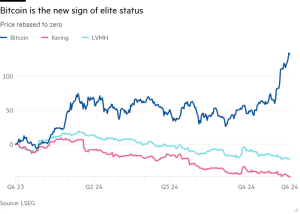Public health in global south faces vaccine cold storage challenge
Unlock the Editor’s Digest for free
Roula Khalaf, Editor of the FT, selects her favourite stories in this weekly newsletter.
The authors are recipients of funding by the European Journalism Centre, through the Solutions Journalism Accelerator. This programme is supported by the Bill & Melinda Gates Foundation
In a remote clinic in the village of New Tafo Akyem, in Ghana, dozens of women bring their babies to be vaccinated against yellow fever. A few years ago, if the vaccine — which is stored at temperatures between 2 and 6 degrees centigrade — had spoiled in the summer heat, the babies would have been turned away, becoming what the World Health Organization euphemistically terms “missed opportunities”.
Today, however, community nurse Gladys Tetteh simply types a toll-free text message into her phone and, 15 minutes later, a toylike drone parachutes an insulated cold bag into the clinic’s grounds. Inside it are vaccines that have survived the journey from a purpose-built, refrigerated distribution centre outside the village of Omenako, about 20km away as the crow flies.
Health experts say the use of drones and cold bags to extend the so-called cold chain in the global south will become a crucial part of the fight against disease as vaccine development progresses.
Nominate a company as an FT ‘Reinvention Champion’

Do you know of a company that has made a clever shift in strategy or business model? If so, tell us via this online entry form (2 minutes to complete). We’ll reveal the FT’s Reinvention Champions on November 13.
This stems from the possibilities offered by the advent of mRNA technology, accelerated by the Covid-19 pandemic to produce vaccines within 300 days. The technology’s success has opened the way for the development of a next generation of vaccines to protect against a far broader range of diseases at a much faster pace than possible using traditional process.
But unlike traditional, live attenuated vaccines, which are made in a way little changed since Edward Jenner gave the first jab in 1796, mRNA-based products require long-term storage at very low temperatures to remain effective.
To prevent them from decaying, mRNA vaccines must be kept below -20 degrees centigrade. Once out of cold storage, they will only remain effective for a few days at standard refrigeration temperatures of between 2 to 8 degrees, in contrast to traditional jabs that can be stored in that range over the long-term.
This drawback is not an issue for rich countries, where medical facilities are seldom more than 100 meters from a refrigerator or a few kilometres from a medical-grade refrigeration unit.
But for many nations in the global south refrigeration remains a challenge. Even traditional live attenuated and protein-adjuvant vaccines spoil before they reach a patient’s arms. According to the WHO, 50 per cent of vaccines are being wasted globally every year — an issue that will only get worse with a heating planet.
Just-in-time deliveries by drones, which leapfrog poor road infrastructure, are key for this so-called vaccine cold rush. As well as in Ghana, they are being used or trialled in Kenya and Ivory Coast.
So is cold-chain training, given that an estimated 30 per cent of vaccine wastage is caused by human error. Rwanda is pioneering a cooling hub, dubbed Aces, in the capital Kigali, which is testing technologies to scale up energy efficient cold chain provision, using artificial intelligence.
At the same time, academic and vaccine manufacturers, including the University of Oxford’s Future Vaccines Manufacturing Hub, VaxHub, are scrambling to make mRNA vaccines more “thermostable”.
All of this work means there is a chance to make vaccine availability fairer, and less climate dependent. During the Covid-19 pandemic, vaccination coverage was iniquitous. Western European countries achieved rates of 85 per cent, compared with just 48 per cent in Sub-Saharan Africa. A country’s wealth was the greatest predictor of the speed of vaccine rollout.
mRNA technology, which is also being trialled to deliver bespoke treatments for cancer and rare metabolic diseases, is particularly valuable in the fight against viruses. Unlike more complex bacteria, viruses hijack human cells to manufacture proteins, a tactic that mRNA vaccines also exploit.
“In a sense, with mRNA vaccines, we are playing viruses at their own game,” says Christopher Green, a clinical academic specialising in Infectious Diseases at the University of Birmingham and an NHS doctor who is involved in vaccine programmes in Rwanda.
In 2021, the Coalition for Epidemic Preparedness Innovations, an international partnership of public, private and philanthropic organisations announced its “100 Days Mission”, with the goal of developing and deploying vaccines within 100 days of a new disease threat emerging. Green says mRNA technology is central to achieving this goal.
An mRNA vaccine to tackle the mpox outbreak, declared a public health emergency by WHO in August, is being evaluated in the UK by the British government’s NIHR Clinical Research Network. It is seen as a key test of the technology as a first line response in the global battle against viral threats, including seasonal flu and haemorrhagic fevers, including Ebola, which have high fatality rates in the global south.
#Public #health #global #south #faces #vaccine #cold #storage #challenge







